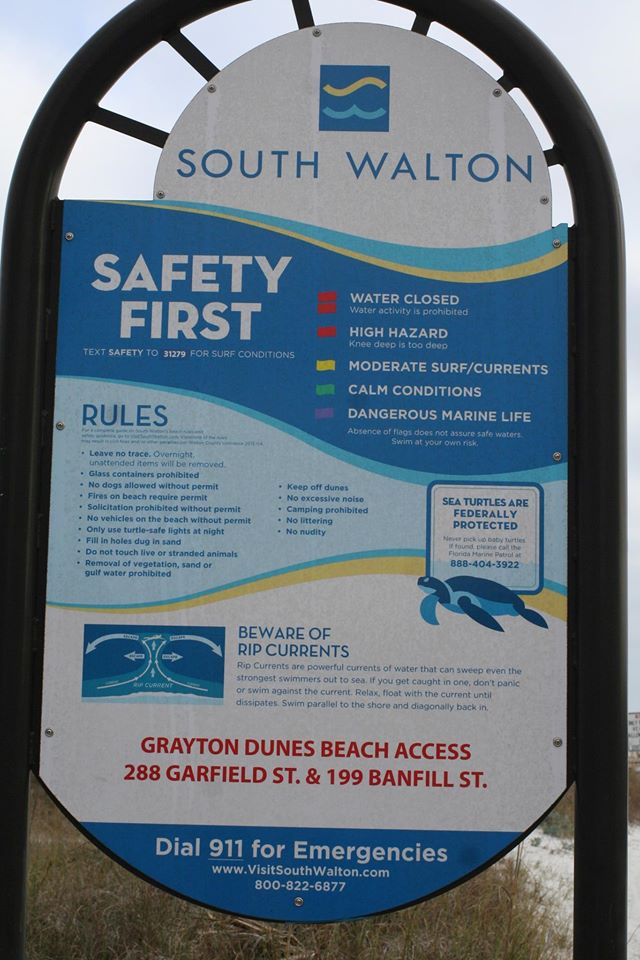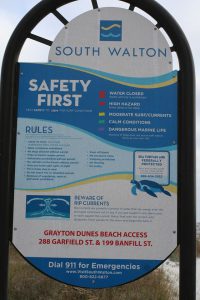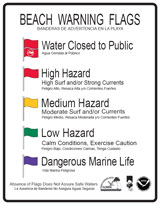
by Laura Tiu | Apr 14, 2017
It was disheartening to read that even with double red flags flying, 22 people had to be recused from the Gulf near Destin, FL recently, and one person lost their life. In that spirit, I believe it is important to review information on the importance of respecting our sometimes-unforgiving gulf.
First of all, stay calm.

Photo By: Laura Tiu
Swimmers getting caught in rip currents make up the majority of lifeguard rescues. These tips from Florida Sea Grant and the National Oceanic and Atmospheric Administration’s National Weather Service (NWS) can help you know what to do if you encounter a rip current.
What Are Rip Currents?
Rip currents are formed when water flows away from the shore in a channeled current. They may form in a break in a sandbar near the shore, or where the current is diverted by a pier or jetty.
From the shore, you can look for these clues in the water:
- A channel of choppy water.
- A difference in water color.
- A line of foam, seaweed, or debris moving out to sea.
- A break in incoming wave patterns.
If you get caught in a rip current, don’t panic! Stay calm and do not fight the current. Escape the current by swimming across it–parallel to shore–until you are out of the current. When you get out of it, swim back to the shore at an angle away from the current. If you can’t break out of the current, float or tread water until the current weakens. Then swim back to shore at an angle away from the rip current. Rip currents are powerful enough to pull even experienced swimmers away from the shore. Do not try to swim straight back to the shore against the current.
Tips for Swimming Safely
You can swim safely this summer by keeping in mind some simple rules. Many people have harmed themselves trying to rescue rip current victims, so follow these steps to help someone stuck in a rip current. Get help from a lifeguard. If a lifeguard is not present, yell instructions to the swimmer from the shore and call 9-1-1. If you are a swimmer caught in a rip current and need help, draw attention to yourself–face the shore and call or wave for help.

Photo by: Laura Tiu
How Do I Escape a Rip Current?
- Rip currents pull people away from shore, not under the water. Rip currents are not “undertows” or “rip tides.”
- Do not overestimate your swimming abilities. Be cautious at all times.
- Never swim alone.
- Swim near a lifeguard for maximum safety.
- Obey all instructions and warnings from lifeguards and signs.
- If in doubt, don’t go out!
Adapted and excerpted from: “Rip Currents” Florida Sea Grant
The Foundation for the Gator Nation, An Equal Opportunity Institution.

by Chris Verlinde | Apr 8, 2016

The sugary white sands along the Panhandle, attract millions of visitors to our area throughout the year. It is important for locals and visitors to understand and consider the following tips for safety at the beach.
The danger of rip currents far outweighs the danger of having a shark encounter. As a result of past storms, the nearshore sandbars along our beaches have changed and the frequency of rip currents has increased. A rip current is a turbulent, fast flowing current that can carry a swimmer out to sea very quickly. The currents are formed when water rushes out to sea in a narrow path (like a break in the nearshore sandbar or from an obstruction of the current caused by a groin or jetty or other type of barrier). Rip currents can last for a few hours or may be permanent; they usually exist when the surf is rough and after storms, but can occur on calm days.
Some signs of rip currents include:
- A difference in water color. The water may be murkier from increased sediments or appear darker because it is deeper.
- A channel of churning, choppy water.
- A line of foam, seaweed or debris being carried directly out to sea.
Rip currents can be difficult to spot. Wearing polarized sunglasses will help you recognize changes in water color. Click here to learn more about rip currents.
If you are caught in a rip current, try not to panic or swim against the current. Swim to the left or right of the current, parallel to shore until you are out of the current. Rip currents range in width from a few feet to many feet wide. If you can’t break out of the current, float calmly out until it ends, usually just beyond the breakers. Then swim diagonally to shore.
Remember, always use common sense and swim responsibly. For current surf conditions check out the National Weather Service rip current forecast.
Know the meaning of the beach warning flags:
 A double red flagmeans the water is closed to the public.
A double red flagmeans the water is closed to the public.- A single red flag means the surf is very dangerous and you should stay out of the water.
- A yellow flag indicates that you should take caution when in the water.
- A green flag indicates that conditions are safe for swimming.
- A purple flag means there could be dangerous marine life such as jellyfish.
When swimming at the beach it is important to remember that the Gulf of Mexico is a wilderness, not a swimming pool. Use common sense when enjoying the Gulf. Some safety tips to remember include:
- Swim near a life guard.
- Know your swimming abilities and limits, if you can’t swim stay out of the water.
- Swim in groups or use the buddy system; never swim alone.
- Be aware of weather conditions; get out of the water and away from the beach during electrical storms. Taking shelter in a building is best, but otherwise a car.
- Always enter the water, feet first every time!
- Don’t swim in murky waters or between dusk and dawn.
- Stay calm in the event of an emergency.
- Pay attention and know the meaning of beach warning flags. Pay attention to lifeguards.
- Avoid swimming in areas where people are fishing.
- To avoid being stung by a sting ray, shuffle your feet, this will stir up the sand and scare away sting rays.
- Always wear sunscreen or protect your skin with clothing.
- If you see someone in trouble, get help from a lifeguard, have someone call 9-1-1. Throw the victim something that will float and yell instructions on how to escape. Remember, many drown while trying to save someone from a rip current.
Follow these tips to help make a visit to the beach a safe one!





